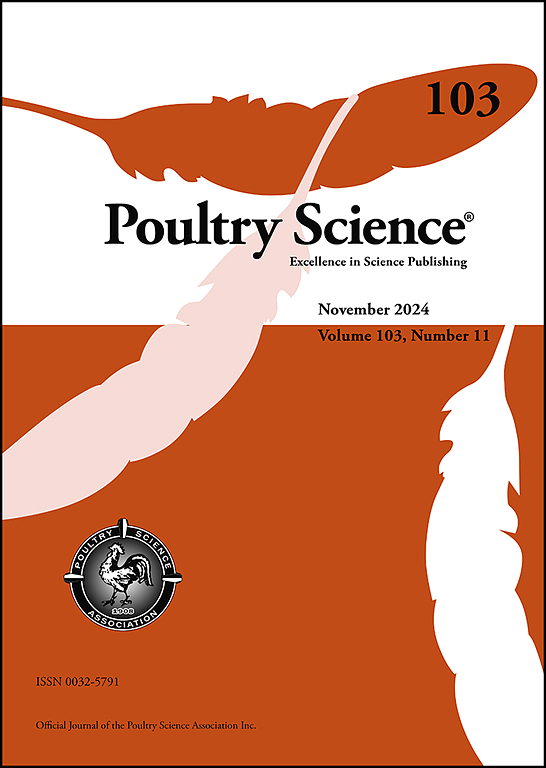Walking a thin line: Thinning broiler houses with Salmonella contaminated material
IF 4.2
1区 农林科学
Q1 AGRICULTURE, DAIRY & ANIMAL SCIENCE
引用次数: 0
Abstract
Salmonella Infantis and Salmonella Paratyphi B var. Java are important human pathogens that are mainly found on chicken meat and derivative products. Furthermore, both serovars are dominantly present in the Belgian broiler sector. In search of contamination routes in the sector, equipment used during partial depopulation or thinning was sampled at ten different broiler farms. All thinning materials, such as the trucks, crates and workwear of the catching crew were sampled before entering the broiler houses. To evaluate if the remaining birds became colonized by Salmonella strains introduced during thinning, the broiler houses were sampled twice using overshoes. Once immediately before thinning and approximately one week after thinning, immediately before final depopulation. The results show that during nine of the ten thinning events Salmonella was present on the equipment used. Especially the crates and loading surfaces of the trucks were frequently contaminated, 19.3 % (62/320) of the sampled crates and 50 % (11/22) of the sampled trucks were found contaminated with S. Infantis, Paratyphi B var. Java or Livingstone. The relative prevalences of S. Infantis, Java and Livingstone were, respectively, 31.3 %, 67.5 % and 1.3 %. Despite the presence of Salmonella during thinning, no cross-contamination to the remaining chickens was observed. A low abundance of Salmonella bacteria, a higher resistance of the older (five weeks), remaining chickens or a small sampling size can explain these results. Nevertheless, the results of this case report underscore the importance of appropriate biosecurity during thinning.
小心行事:用沙门氏菌污染的材料使肉鸡房变薄
婴儿沙门氏菌和爪哇副伤寒沙门氏菌是重要的人类致病菌,主要存在于鸡肉及其衍生物中。此外,这两种血清型主要存在于比利时肉鸡部门。为了寻找该部门的污染途径,在10个不同的肉鸡养殖场取样了部分种群减少或间伐期间使用的设备。所有减薄材料,如卡车、板条箱和捕捞人员的工作服,在进入肉鸡舍之前都进行了取样。为了评估在间伐期间引入的沙门氏菌菌株是否在剩余的禽类中定植,使用套鞋对肉鸡舍进行了两次采样。一次是在减薄之前,一次是在减薄后大约一周,在最终种群减少之前。结果表明,在10次稀释事件中,有9次沙门氏菌存在于所使用的设备上。其中板条箱和货车装货面污染最为严重,19.3%(62/320)的板条箱和50%(11/22)的货车被发现感染了婴儿链球菌、乙型副伤寒变种Java和Livingstone。相对患病率分别为31.3%、67.5%和1.3%。尽管在稀释过程中存在沙门氏菌,但未观察到对剩余鸡的交叉污染。沙门氏菌丰度低、年龄较大(5周)的鸡具有较高的耐药性、剩余的鸡或样本量小可以解释这些结果。尽管如此,本病例报告的结果强调了间伐期间适当的生物安全的重要性。
本文章由计算机程序翻译,如有差异,请以英文原文为准。
求助全文
约1分钟内获得全文
求助全文
来源期刊

Poultry Science
农林科学-奶制品与动物科学
CiteScore
7.60
自引率
15.90%
发文量
0
审稿时长
94 days
期刊介绍:
First self-published in 1921, Poultry Science is an internationally renowned monthly journal, known as the authoritative source for a broad range of poultry information and high-caliber research. The journal plays a pivotal role in the dissemination of preeminent poultry-related knowledge across all disciplines. As of January 2020, Poultry Science will become an Open Access journal with no subscription charges, meaning authors who publish here can make their research immediately, permanently, and freely accessible worldwide while retaining copyright to their work. Papers submitted for publication after October 1, 2019 will be published as Open Access papers.
An international journal, Poultry Science publishes original papers, research notes, symposium papers, and reviews of basic science as applied to poultry. This authoritative source of poultry information is consistently ranked by ISI Impact Factor as one of the top 10 agriculture, dairy and animal science journals to deliver high-caliber research. Currently it is the highest-ranked (by Impact Factor and Eigenfactor) journal dedicated to publishing poultry research. Subject areas include breeding, genetics, education, production, management, environment, health, behavior, welfare, immunology, molecular biology, metabolism, nutrition, physiology, reproduction, processing, and products.
 求助内容:
求助内容: 应助结果提醒方式:
应助结果提醒方式:


